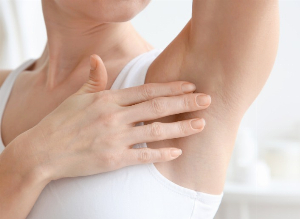Healthy lifestyle for a better management of Verneuil's disease (Hidradenitis suppurativa)
Published 6 Jun 2024 • By Candice Salomé
Verneuil's disease (Hidradenitis suppurativa) is a chronic skin condition characterised by painful nodules and abscesses that progress to pus discharge, fistulae and increased scarring.
There are several stages of severity for Verneuil's disease, and the appropriate treatment will depend on the stage. However, there are a number of dietary and lifestyle rules that can help relieve the symptoms of Verneuil's disease.
So what are the symptoms and causes of Verneuil's disease? How is it treated? And what advice can be given to patients on the everyday management of the condition?
We explain it all in our article!

What is Verneuil's disease?
Verneuil's disease, or Hidradenitis suppurativa, is a chronic skin condition described by the surgeon of the same name in 1854. It is also sometimes called acne inversa.
It is characterised by painful nodules (rounded, protruding skin formations) and abscesses (clusters of pus collected in a cavity), which develop into pus discharge, fistulae (a channel through which fluid drains) and increased scarring.
The disease affects the areas with numerous sweat glands, such as the armpits, groin, gluteal cleft, breasts and, more rarely, the nape of the neck. Some forms of Verneuil's disease are accompanied by severe acne of the face and/or trunk.
Verneuil's disease affects both men and women, with a slight predominance of women. It generally begins in adolescence or young adulthood.
The exact cause of Verneuil's disease is not known. Hormonal factors have been suggested, as there are changes in the disease during pregnancy or menstruation. In addition, the disease rarely starts before puberty or after the menopause. However, to date, no study has been able to identify the exact role of hormonal factors in the development of Verneuil's disease.
Infection by bacteria such as streptococcus or staphylococcus is often present in the early stages of the disease, but is not its initial cause.
Smoking could be a triggering factor but, again, this has not been clearly demonstrated by scientific research.
Finally, Verneuil's disease may have a genetic component, since in some families the disease is present in several members.
Verneuil's disease is neither contagious nor sexually transmitted.
What is the treatment for Verneuil's disease?
The course of Verneuil's disease can be divided into 3 stages, according to the Hurley classification. This classification enables the most appropriate treatment to be chosen:
- Stage 1: nodules contain few microbes. Remission is normally achieved within 6 weeks after targeted antibiotic therapy.
- Stage 2: the disease is of intermediate severity. The lesions leave gaps of healthy skin in the affected areas. They contain a richer diversity of bacteria than Hurley stage 1 lesions, but much less than stage 3 lesions.
- Stage 3: In this stage, the bacteria are very numerous, varied and resistant, with no gaps of healthy skin in the affected areas.
Stages 2 and 3 of Verneuil's disease are treated with a heavy course of antibiotics targeted against the pathogens, with treatment lasting from 3 to 6 months. Patients in remission are then closely monitored.
For the most severely affected patients, surgical removal of the affected areas allows long-term remission. Maintenance treatment is required after surgery.
What dietary and lifestyle advice should be given to Verneuil's disease patients?
In the management of Verneuil's disease, certain lifestyle rules are recommended to help patients improve their quality of life and reduce the number of relapses.
Smoking
Stopping smoking is strongly recommended, although no study to date has established a correlation between smoking and the development of Verneuil's disease. However, it has been found that Verneuil's disease is often associated with heavy smoking. In addition, smoking prevents proper healing.
The use of deodorants
Deodorants, particularly roll-on deodorants and sprays, can cause pores to clog, so it is recommended not to use this type of product.
Hair removal
To remove hair from sensitive areas, it is not recommended to use razors with blades, as they not only encourage injury but also subcutaneous regrowth, which can be a trigger for a new outbreak.
It is preferable to use an electric epilator, which removes the entire hair bulb, or a hair clipper.
Drying
To avoid maceration, we recommend strict personal hygiene and careful drying of folds with a clean, dry cloth, or using a hairdryer on affected areas.
Clothes
As well as causing discomfort to the lesions, clothing made from synthetic materials can be a trigger for new outbreaks. Wearing loose-fitting cotton clothes is strongly recommended.
Controlling your weight
There is no link between Verneuil's disease and obesity, but people with excess weight are advised to adopt a healthy diet, as poor diet is an aggravating factor and causes a worse response to treatment. The Mediterranean diet can be a great option, as it is recognised for its many health benefits.
Was this article helpful to you?
Give it a "Like" and share your thoughts and questions with the community in the comments below!
Take care!
Comments
You will also like

Adalimumab (Humira®, Amgevita®, Imraldi®, Idacio®, Hyrimoz® and Yuflyma®): everything there is to know!
26 Jan 2023

 Facebook
Facebook Twitter
Twitter

